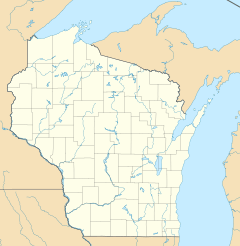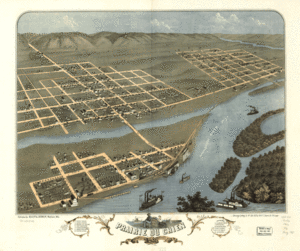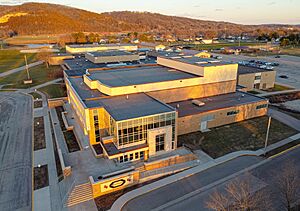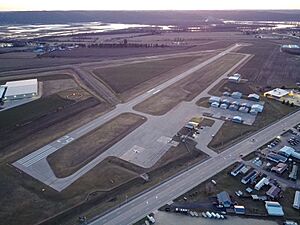Prairie du Chien, Wisconsin facts for kids
Quick facts for kids
Prairie du Chien, Wisconsin
|
|
|---|---|
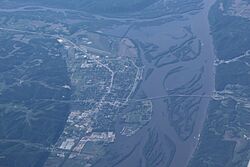
Aerial photo of Prairie du Chien
|
|
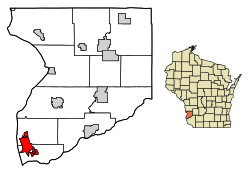
Location of Prairie du Chien in Crawford County, Wisconsin
|
|
| Municipality | City |
| Area | |
| • Total | 6.47 sq mi (16.76 km2) |
| • Land | 5.84 sq mi (15.13 km2) |
| • Water | 0.63 sq mi (1.63 km2) |
| Population
(2020)
|
|
| • Total | 5,506 |
| • Density | 942.3/sq mi (363.8/km2) |
| Time zone | UTC−6 (Central) |
| • Summer (DST) | UTC−5 (CDT) |
| ZIP Code |
53821
|
| Area code(s) | 608 |
| FIPS code | 55-65050 |
| Website | www.prairieduchien.info |
Prairie du Chien is a city in Wisconsin, United States. It is the main city of Crawford County. In 2020, about 5,506 people lived there. Many people call Prairie du Chien Wisconsin's second-oldest city. French explorers started a settlement here in the late 1600s. This makes it one of the oldest European settlements in the Midwestern United States. The city has many places that show its long and interesting history.
Prairie du Chien is located where the Wisconsin River meets the Mississippi River. This spot was very important for travel between the Great Lakes and the Mississippi River. Early French visitors found the area was home to a group of Fox Indians. Their chief's name, Alim, meant 'dog' in French. So, the French explorers named the place Prairie du Chien, which means 'dog's meadow'. This name first described the flat land, but later it became the city's name.
Contents
History of Prairie du Chien
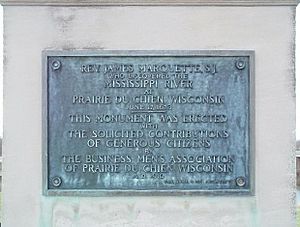
The first Europeans known to arrive here were French explorers Jacques Marquette and Louis Joliet. They came by canoe on June 17, 1673. They found a new way to the Mississippi River. Later, travelers between Canada and the Mississippi River often passed through Prairie du Chien.
In 1685, French explorer Nicolas Perrot set up a trading post here. This was part of the big and profitable French fur trade. The fur trade was very important in Prairie du Chien until the mid-1800s. At that time, people in Europe wanted fewer furs, and there were fewer animals to hunt.
Changes in Control and Forts
In 1763, Great Britain won a war against France. Britain then took control of French lands in North America east of the Mississippi River, including Prairie du Chien. During the American Revolutionary War, the city was a meeting place for British soldiers and their Native American allies.
After America won the war, the Treaty of Paris gave the area to the new United States. But the British were slow to leave. Prairie du Chien became fully American only after the War of 1812.

The U.S. government built Fort Shelby in 1814 to protect the area. But British soldiers captured it during the Siege of Prairie du Chien that same year. The British held the city until the war ended in 1815. To prevent another invasion, the Americans built Fort Crawford in 1816.
Important Events at Fort Crawford

Fort Crawford was where important agreements called the Treaties of Prairie du Chien were signed. These treaties, in 1825 and 1830, meant that the Fox and Sauk tribes gave up much of their land to the U.S.
In 1829, an army doctor named William Beaumont did many experiments at Fort Crawford's hospital. His discoveries about how the human body digests food are still important today.
Colonel Zachary Taylor, who later became a U.S. president, was in charge of Fort Crawford during the Black Hawk War in 1832. He oversaw the surrender of Black Hawk in Prairie du Chien. Lieutenant Jefferson Davis, who later led the Confederate States of America, was also stationed there. He met Taylor's daughter, Sarah "Knoxie" Taylor, and they married in 1835.
Life After the Fur Trade
After the fur trade slowed down, Prairie du Chien focused on farming and railroads. In 1857, the city got its first railroad connection. It was hard to get trains across the wide Mississippi River. So, trains were taken apart, ferried across, and put back together on the other side.
A better idea came in 1874. Michael Spettel and John Lawler designed a special bridge called the Pile-Pontoon Railroad Bridge. This bridge could float and let trains cross the river. Lawler made a lot of money from this invention. The bridge was used until 1961.
John Lawler later gave land to start two Catholic schools in Prairie du Chien. These were St. Mary's Institute and Campion High School. Campion High School had many famous students, including actors and politicians. It closed in 1975.
Villa Louis Mansion
One of Prairie du Chien's richest fur traders was Hercules L. Dousman. He made a fortune from furs and other investments. He became Wisconsin's first millionaire. After he died in 1868, his son, H. Louis Dousman, built a beautiful Victorian house called "Villa Louis" in 1870. The Dousman family lived there until 1913. In 1952, Villa Louis became Wisconsin's first state historic site.
Geography and Climate
Prairie du Chien is located in the Mississippi River Valley. It sits on a long, flat area of land. The Mississippi River is to the west, the Wisconsin River to the south, and tall hills called bluffs to the east. The city covers most of this flat area.
Just north of the city is a small area called Frenchtown. South of the city, the flat land ends and becomes the wetlands of the Wisconsin River delta. Sometimes, parts of the Mississippi River flow over the western side of the plain, creating small islands. Most of these islands are too small to live on.
One island, called St. Feriole Island, is now a large city park. In 1965, a flood forced people living there to move to higher ground. Now, it's a great place for outdoor activities.
Weather in Prairie du Chien
Prairie du Chien has recorded some of Wisconsin's highest temperatures for several months of the year.
| Climate data for Prairie du Chien, Wisconsin (1991–2020 normals, extremes 1893–present) | |||||||||||||
|---|---|---|---|---|---|---|---|---|---|---|---|---|---|
| Month | Jan | Feb | Mar | Apr | May | Jun | Jul | Aug | Sep | Oct | Nov | Dec | Year |
| Record high °F (°C) | 66 (19) |
70 (21) |
89 (32) |
96 (36) |
109 (43) |
105 (41) |
110 (43) |
106 (41) |
104 (40) |
93 (34) |
85 (29) |
70 (21) |
110 (43) |
| Mean maximum °F (°C) | 46.7 (8.2) |
52.6 (11.4) |
68.6 (20.3) |
79.7 (26.5) |
87.2 (30.7) |
92.1 (33.4) |
93.0 (33.9) |
91.6 (33.1) |
88.5 (31.4) |
82.4 (28.0) |
66.4 (19.1) |
51.9 (11.1) |
95.0 (35.0) |
| Mean daily maximum °F (°C) | 27.1 (−2.7) |
32.1 (0.1) |
44.9 (7.2) |
58.6 (14.8) |
70.2 (21.2) |
79.6 (26.4) |
83.1 (28.4) |
81.3 (27.4) |
74.2 (23.4) |
61.7 (16.5) |
45.9 (7.7) |
32.9 (0.5) |
57.6 (14.2) |
| Daily mean °F (°C) | 18.4 (−7.6) |
22.7 (−5.2) |
34.9 (1.6) |
47.6 (8.7) |
59.2 (15.1) |
69.2 (20.7) |
73.1 (22.8) |
71.1 (21.7) |
63.1 (17.3) |
50.9 (10.5) |
37.0 (2.8) |
25.0 (−3.9) |
47.7 (8.7) |
| Mean daily minimum °F (°C) | 9.7 (−12.4) |
13.3 (−10.4) |
24.9 (−3.9) |
36.6 (2.6) |
48.2 (9.0) |
58.9 (14.9) |
63.1 (17.3) |
61.0 (16.1) |
52.0 (11.1) |
40.1 (4.5) |
28.2 (−2.1) |
17.1 (−8.3) |
37.8 (3.2) |
| Mean minimum °F (°C) | −13.5 (−25.3) |
−8.1 (−22.3) |
3.5 (−15.8) |
22.4 (−5.3) |
33.2 (0.7) |
45.3 (7.4) |
52.2 (11.2) |
51.2 (10.7) |
37.3 (2.9) |
25.0 (−3.9) |
12.2 (−11.0) |
−4.4 (−20.2) |
−17.4 (−27.4) |
| Record low °F (°C) | −37 (−38) |
−36 (−38) |
−33 (−36) |
0 (−18) |
21 (−6) |
34 (1) |
38 (3) |
35 (2) |
20 (−7) |
4 (−16) |
−17 (−27) |
−26 (−32) |
−37 (−38) |
| Average precipitation inches (mm) | 1.22 (31) |
1.26 (32) |
2.05 (52) |
4.04 (103) |
4.68 (119) |
5.83 (148) |
4.12 (105) |
4.15 (105) |
3.99 (101) |
2.72 (69) |
2.12 (54) |
1.56 (40) |
37.74 (959) |
| Average snowfall inches (cm) | 9.0 (23) |
8.6 (22) |
4.3 (11) |
1.4 (3.6) |
0.0 (0.0) |
0.0 (0.0) |
0.0 (0.0) |
0.0 (0.0) |
0.0 (0.0) |
0.2 (0.51) |
1.5 (3.8) |
8.8 (22) |
33.8 (86) |
| Average precipitation days (≥ 0.01 in) | 7.7 | 6.9 | 7.8 | 10.5 | 11.9 | 11.2 | 9.0 | 8.4 | 8.5 | 8.3 | 6.6 | 7.9 | 104.7 |
| Average snowy days (≥ 0.1 in) | 5.6 | 5.0 | 2.0 | 0.6 | 0.0 | 0.0 | 0.0 | 0.0 | 0.0 | 0.1 | 1.0 | 4.7 | 19.0 |
| Source: NOAA | |||||||||||||
People of Prairie du Chien
| Historical population | |||
|---|---|---|---|
| Census | Pop. | %± | |
| 1860 | 2,398 | — | |
| 1870 | 2,700 | 12.6% | |
| 1880 | 2,777 | 2.9% | |
| 1890 | 3,131 | 12.7% | |
| 1900 | 3,232 | 3.2% | |
| 1910 | 3,149 | −2.6% | |
| 1920 | 3,537 | 12.3% | |
| 1930 | 3,943 | 11.5% | |
| 1940 | 4,622 | 17.2% | |
| 1950 | 5,392 | 16.7% | |
| 1960 | 5,649 | 4.8% | |
| 1970 | 5,540 | −1.9% | |
| 1980 | 5,859 | 5.8% | |
| 1990 | 5,659 | −3.4% | |
| 2000 | 6,018 | 6.3% | |
| 2010 | 5,911 | −1.8% | |
| 2020 | 5,506 | −6.9% | |
| U.S. Decennial Census | |||
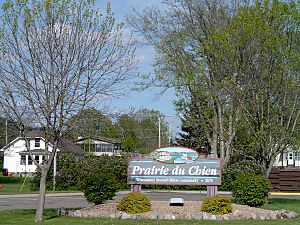
Population in 2020
In 2020, Prairie du Chien had 5,506 people. Most people (90.1%) were White. About 4.3% were Black or African American. Other groups included Native American, Asian, and people of two or more races. About 2.5% of the population was Hispanic or Latino.
The average age in the city was 45.6 years old. About 16.6% of residents were under 18. About 22.3% were 65 or older. There were slightly more males (54.4%) than females (45.6%) in the city.
Economy and Jobs
Prairie du Chien's economy is much like other cities its size in the Midwest. Many people work in retail stores, service jobs, and manufacturing. The city also has a larger-than-average number of tourists.
Big employers in the city include 3M and Cabela's. Government jobs are also important, as the city has the Crawford County courthouse and a state prison. Prairie du Chien has one of Wisconsin's busiest ports on the Mississippi River. Two railroads and a local airport help make the city a center for transport and shipping in the area.
Arts and Culture
Prairie du Chien has five National Historic Landmarks. These are important places recognized for their history. It also has nine sites listed on the National Register of Historic Places.
The city is close to beautiful natural areas like Wyalusing State Park in Wisconsin. It is also near Effigy Mounds National Monument and Pikes Peak State Park in Iowa. These places are popular for their natural beauty and ancient mounds.
Because of its rich history and location by the Mississippi River, many tourists visit Prairie du Chien. Every Father's Day weekend since 1975, the city hosts the Prairie Villa Rendezvous. This event recreates a 19th-century fur trading camp and attracts thousands of visitors.
Since 2001, Prairie du Chien has had a unique New Year's Eve celebration. At midnight, a large fish called a carp is dropped from a crane. This event is known as the "Droppin' of the Carp."
Hunting and fishing are very popular activities in the area. The opening of a Cabela's store in 1998 made the city an even bigger destination for people who love outdoor sports.
Parks and Recreation
St. Feriole Island has a long riverfront with a park. There is also a bike path that goes around the island. The park has shelters for big events. Near the Villa Louis, there is a large open field that was once a horse racing track. Now, it has two large soccer fields. Pets are allowed to run in these fields.
The GRABAAWR bike tour, a seven-day, 500-mile bike ride across Wisconsin, ends in Prairie du Chien.
Education
The Prairie du Chien Area School District serves Prairie du Chien and the nearby village of Eastman. The district has three schools, all located in Prairie du Chien:
- B. A. Kennedy Elementary School (for young children up to grade 1).
- Bluff View Intermediate School (grades 2–8).
- Prairie du Chien High School (grades 9–12).
The main offices for the school district are at B. A. Kennedy Elementary School.
There are also private schools in Prairie du Chien. Prairie Catholic School is a K-8 school connected to local Catholic churches. Prairie Christian Academy is a K-12 school linked to Bible Baptist Church.
Media and News
Prairie du Chien has a newspaper called the Courier Press. It comes out twice a week. Another local paper is the Wisconsin-Iowa Shopping News.
The city also has local radio stations. WQPC broadcasts at 94.3 FM and its sister station, WPRE, is at 980 AM.
Transportation
Bus service to La Crosse is available three times a day. Prairie du Chien also has its own airport, the Prairie du Chien Municipal Airport.
Notable People
- Matthew Antoine (born 1985), won a bronze medal in skeleton at the 2014 Winter Olympics.
- William Beaumont, an Army doctor in the 1820s, studied how humans digest food at Fort Crawford.
- Barbara Bedford (1908–1981), an actress from silent films and Westerns.
- Nicholas Boilvin (1761–1827), a frontiersman in the 1800s.
- Pat Bowlen (1944–2019), former owner of the Denver Broncos football team.
- Michel Brisbois (1759–1837), a fur trader.
- Walter Bradford Cannon (1871–1945), a scientist who studied how the body reacts to stress.
- Jefferson Davis, who later became president of the Confederate States of America, was stationed at Fort Crawford in the 1830s.
- Hercules Louis Dousman (1800–1868), a wealthy businessman and Wisconsin's first millionaire.
- Johann Georg Hagen (1847–1930), a Jesuit priest and astronomer.
- Henry Leavenworth (1783–1834), a U.S. Army officer.
- James Henry Lockwood (1793–1857), a lawyer and fur trapper.
- Patrick Joseph Lucey (1918–2014), a U.S. diplomat and former Governor of Wisconsin.
- John Muir (1838–1914), a famous conservationist who helped start the Sierra Club.
- Leo Ryan (1925–1978), a U.S. Representative from California.
- Jeremiah Burnham Tainter (1836–1920), an engineer who invented the Tainter gate.
- George Wendt (born 1948), an actor known for his role in the TV show Cheers.
See also
 In Spanish: Prairie du Chien para niños
In Spanish: Prairie du Chien para niños


